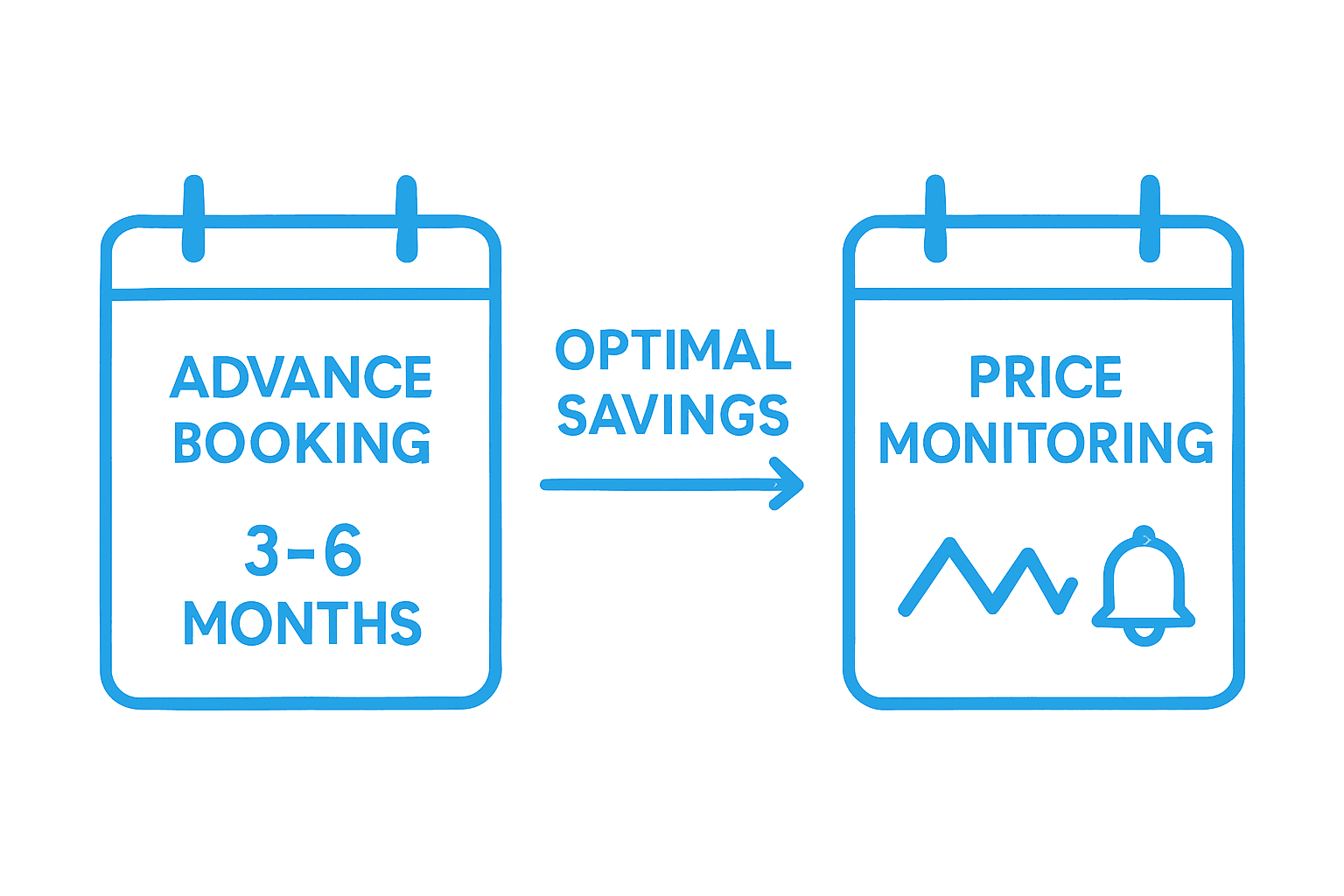Finding cheap flights can feel like chasing a moving target. Prices change by the hour, and just when you think you have a good deal, it vanishes. But most people miss one simple fact—booking your flight just three to six months in advance can save you hundreds of dollars compared to last minute prices. The smartest workaround is not working harder, but working smarter with a flexible travel plan that keeps the savings rolling in.
Table of Contents
- Step 1: Set A Flexible Travel Schedule
- Step 2: Utilize Flight Search Engines
- Step 3: Compare Alternative Airports
- Step 4: Sign Up For Fare Alerts
- Step 5: Book In Advance And Monitor Prices
Quick Summary
| Key Point | Explanation |
|---|---|
| 1. Set a flexible travel schedule | Being open to changing travel dates can lead to significant savings on flights. Flexibility allows for seizing unexpected price drops. |
| 2. Utilize multiple flight search engines | Explore various flight search platforms to uncover rare deals. Each search engine may have unique features that facilitate finding budget options. |
| 3. Compare different airports | Assess regional airports for potential savings. Sometimes flying from or to smaller airports offers lower fares compared to major hubs. |
| 4. Sign up for fare alerts | Create alerts on platforms for real-time notifications on price drops. This proactive approach keeps you informed about the best deals available. |
| 5. Book in advance and monitor prices | Plan to book flights ahead of time while actively tracking prices. Utilize tools that predict fare trends to optimize timing of ticket purchases. |
Step 1: Set a Flexible Travel Schedule
Setting a flexible travel schedule is your secret weapon in hunting down the most affordable flights. When you approach travel dates with adaptability, you unlock significant savings potential that rigid planning simply cannot match. Flexibility is the cornerstone of budget travel, allowing you to capitalize on unexpected price drops and promotional windows.
The key strategy involves understanding that flight prices fluctuate dramatically based on timing, demand, and seasonal variations. By remaining open to shifting your departure and return dates by a few days or even weeks, you can potentially save hundreds of dollars. Airlines and booking platforms frequently offer lower prices on less popular travel days such as midweek departures or red-eye flights.
To implement this approach effectively, you’ll want to leverage advanced search tools that support flexible date searching. Many travel websites now offer calendars showing price variations across multiple dates, enabling you to visually compare costs. Check out our guide on finding cheap flights for more detailed strategies on utilizing these powerful comparison tools.
Consider creating price alerts for your preferred routes, which will notify you instantly when fares drop. Some travelers even intentionally plan trips around known low-price periods, such as shoulder seasons when destinations are less crowded but still enjoyable. This might mean traveling in early spring instead of peak summer or exploring European cities in late autumn when prices plummet but pleasant weather remains.
Remember that true flexibility extends beyond just dates. Being open to alternative departure airports within reasonable driving distance can also yield surprising savings. A two-hour drive to a different airport might translate into flight prices significantly lower than your closest regional hub. Always run comparative searches across multiple airports to maximize your potential for discovering unexpected deals.
Step 2: Utilize Flight Search Engines
Mastering the art of flight search engines transforms your travel planning from frustrating to fantastic. Modern search platforms are powerful tools that can uncover flight deals most travelers never see, providing a strategic advantage in finding budget friendly travel options. These digital platforms aggregate pricing information from multiple airlines and travel agencies, creating a comprehensive view of available routes and prices.
To maximize your search effectiveness, start by exploring multiple search engines simultaneously. Websites like Skyscanner, Google Flights, and Kayak offer sophisticated search algorithms that compare prices across numerous carriers. Each platform has unique features that can reveal hidden savings. Pro tip: Use incognito or private browsing mode to prevent websites from tracking your searches and potentially raising prices based on your browsing history.
Learn more about understanding travel booking sites to refine your search strategy. Some advanced search engines allow you to set up price alerts, track fare trends, and even predict future price movements. This means you can strategically time your booking to capture the most competitive rates.
Experienced travelers recommend using meta search engines that scan multiple booking platforms simultaneously. These tools can quickly reveal price variations across different websites, potentially saving you significant money. Some platforms even offer features like price prediction algorithms that suggest whether you should book immediately or wait for potential future price drops.
Remember that no single search engine provides definitive results. Cross referencing multiple platforms helps ensure you’re discovering the most comprehensive range of flight options. Pay attention to additional costs like baggage fees and seat selection, which can significantly impact the total price. Some search engines now include these additional costs in their initial price displays, providing a more transparent view of the true travel expense.
Below is a comparison of popular flight search engines, highlighting their unique features and best uses to help you select the right tools for finding cheap flights.
| Search Engine | Unique Features | Best For |
|---|---|---|
| Skyscanner | Flexible date search, wide range of airlines & agencies | Comparing global routes and flexible dates |
| Google Flights | Price trend graphs, predictive fare analysis, easy alerts | Visualizing price changes and fare prediction |
| Kayak | Meta search, price alerts, baggage fee display | Finding hidden deals, tracking total costs |
| Momondo | Deep price comparisons, alternative airport suggestions | Exploring lesser-known options and savings |
| Airline Websites | Direct booking, special web-only offers | Accessing exclusive deals and loyalty benefits |
The ultimate goal is transforming flight searching from a tedious task into a strategic process. By approaching search engines with patience, curiosity, and a systematic method, you’ll consistently uncover travel opportunities that make your budget travel dreams a reality.
Step 3: Compare Alternative Airports
Comparing alternative airports is a strategic approach that can dramatically reduce your travel expenses. Not all airports are created equal, and savvy travelers understand that flexibility in departure and arrival points can unlock significant savings. Think beyond your nearest airport and consider regional alternatives within a reasonable driving distance.
Start by mapping out all airports within a three to four hour driving radius of your home and destination. Major metropolitan areas often have multiple airports serving different regions, each with unique pricing structures and airline partnerships. For instance, flying into a smaller regional airport might cost substantially less than a major international hub, even when accounting for additional ground transportation expenses.
Explore the benefits of travel comparison strategies to refine your airport selection process. Some travelers report saving hundreds of dollars by being willing to drive an extra hour to a different airport or choose a slightly less convenient arrival point.
Technology makes this research easier than ever. Modern flight search engines allow you to input multiple airport codes simultaneously, generating comprehensive price comparisons across different locations. This approach requires some additional planning but can yield remarkable financial benefits. Consider factors like parking costs, ground transportation, and total travel time when evaluating alternative airport options.
Public transportation can further enhance your savings strategy. Some regional airports are conveniently connected to major cities through train or bus services, making them attractive options for budget conscious travelers. Look beyond direct flight costs and calculate the total transportation expense from your origin to your final destination.
The most successful airport comparison strategy involves combining multiple tactics. Use flight search engines, check regional airport websites, and remain open to unconventional routing. Some travelers even intentionally book flights with layovers in their desired destination to reduce overall travel expenses. By approaching airport selection as a comprehensive puzzle rather than a straightforward choice, you transform travel planning from a costly necessity into a strategic opportunity for significant savings.

Step 4: Sign Up for Fare Alerts
Fare alerts are the secret weapon of budget travelers, providing real time intelligence about price drops and promotional opportunities. Signing up for these alerts transforms passive travel planning into an active savings strategy, giving you immediate notifications about flight price fluctuations for your desired routes.
Multiple platforms offer sophisticated fare alert services, each with unique features designed to match different traveler needs. Websites like Google Flights, Skyscanner, and airline specific platforms allow you to create customized alerts for specific destinations, date ranges, and price thresholds. The key is setting up multiple alert channels to maximize your chances of catching exceptional deals.
Check out our essential budget travel tips to complement your fare alert strategy. When creating alerts, be as specific as possible about your travel preferences. Include multiple departure and arrival airports, flexible date ranges, and specific price ranges to increase the likelihood of receiving relevant notifications.
Consider creating alerts across different platforms to create a comprehensive monitoring network. Some travelers use a dedicated email address exclusively for travel alerts to keep their primary inbox uncluttered. Pro tip: Many credit card travel portals and frequent flyer programs also offer fare alert services, providing an additional layer of potential savings opportunities.
The most effective fare alert strategy involves a combination of automated notifications and personal vigilance. While alerts are incredibly helpful, they should not replace your own active research. Set up alerts for multiple potential routes, compare prices across different platforms, and be prepared to act quickly when an exceptional deal appears.
Remember that timing is crucial. Some of the best flight deals appear and disappear within hours, so having a responsive alert system can mean the difference between securing an amazing price and missing out. Configure your alerts to send instant mobile notifications, ensuring you can respond immediately to price drops. By treating fare alerts as an ongoing, dynamic process, you transform travel planning from a reactive task into a proactive savings strategy.
Step 5: Book in Advance and Monitor Prices
Advance booking is a nuanced art that can yield substantial savings for strategic travelers. Timing is everything when hunting for affordable flights, with most experts recommending booking international flights 3-6 months ahead and domestic flights 1-3 months before departure. This window provides an optimal balance between early bird pricing and last minute deal potential.
Modern price tracking tools make continuous price monitoring more accessible than ever. Websites and apps now offer sophisticated algorithms that predict price trends, helping travelers determine the most opportune moment to purchase tickets. Some platforms even provide visual price graphs showing historical and projected flight costs, empowering you to make data driven booking decisions.
Explore our comprehensive hotel booking tips to complement your flight booking strategy and create a holistic travel savings approach. Price tracking requires patience and consistent engagement. Set up price tracking alerts across multiple platforms, comparing rates regularly to identify the most advantageous booking window.
Understand that airline pricing is complex and dynamic. Prices fluctuate based on factors like seasonal demand, events, holidays, and even day of the week. Tuesday and Wednesday typically offer lower prices, while weekend and holiday flights tend to be more expensive. Some travelers employ a hybrid strategy of booking partially refundable tickets and continuing to monitor prices, ready to rebook if significant savings emerge.
Technology has revolutionized price monitoring, with machine learning algorithms now predicting price movements with increasing accuracy. Some advanced tools can notify you when prices drop, even after you’ve made a purchase, potentially helping you secure a refund or credit. Pro tip: Many credit cards and travel services offer price protection features that can reimburse the difference if your flight price drops after booking.
Remember that advance booking is not just about finding the lowest price, but about securing availability for your preferred routes and travel times. Popular destinations and peak travel seasons can sell out quickly, making early booking a strategic move beyond mere cost savings. By combining advance booking with continuous price monitoring, you transform travel planning from a gamble into a calculated, intelligent process.
This step overview table summarizes the key actions in the process of finding cheap flights, along with their estimated effort and expected benefits.
| Step | Estimated Effort | Expected Benefit |
|---|---|---|
| Set a flexible travel schedule | Moderate | Unlocks greater savings and access to more deals |
| Utilize multiple flight search engines | Moderate | Reveals rare deals and hidden lower fares |
| Compare alternative airports | Moderate-High | May reduce total travel costs by hundreds of dollars |
| Sign up for fare alerts | Low | Automatic updates on price drops and special discounts |
| Book in advance and monitor prices | Moderate | Increases chances of booking flights at best prices |

Take the Stress Out of Finding Cheap Flights with PilotTravelDeals.com
Are you tired of endlessly searching for affordable flights and still missing out on the best deals? If you have ever struggled with fluctuating prices, the challenge of comparing multiple airports, or the uncertainty of booking at the right time, you are not alone. The journey to smarter travel begins by mastering flexible schedules, using powerful search tools, and understanding fare alerts—all crucial tips covered in our essential guide. Need even more strategies to transform how you book every trip? Explore our Travel Tips section to solve these problems faster and with confidence.

Stop leaving great deals on the table. Join thousands of savvy travelers who rely on PilotTravelDeals.com for real savings on flights, hotels, and more. Visit our site now and see how easy trip planning can be when every option, resource, and expert tip is all in one place. Your next budget-friendly adventure is just a click away.
Frequently Asked Questions
How can I find cheap flights when my travel dates are flexible?
Being flexible with your travel dates allows you to take advantage of lower fares typically offered on less popular days, such as midweek departures. Use flexible date search tools on flight search engines to compare prices across multiple dates and unlock significant savings.
What are fare alerts and how do they help in finding cheap flights?
Fare alerts are notifications that inform you about price drops and special promotions for specific routes. By signing up for alerts on multiple platforms, you can actively monitor ticket prices and snag great deals as soon as they become available.
Why should I compare alternative airports when booking flights?
Comparing alternative airports can lead to substantial savings, as not all airports have the same pricing structures. Evaluating nearby airports within a reasonable driving distance can reveal lower fare options and potentially save you money on your overall travel expenses.
How far in advance should I book my flights to get the best prices?
It’s generally recommended to book international flights 3-6 months in advance and domestic flights 1-3 months ahead of your departure. Booking within this time frame helps balance the likelihood of finding lower prices while ensuring availability for your preferred travel dates.
Recommended
- How to Find Cheap Flights for Your Next Adventure – PilotTravelDeals.com
- 10 Essential Budget Travel Tips for Smart Travelers – PilotTravelDeals.com
- Understanding the Budget Travel Planning Guide – PilotTravelDeals.com
- Understanding Who Sets Airline Fares and Why It Matters – PilotTravelDeals.com
- Top Tips for Saving Money on Travel in the United States – Yopki




